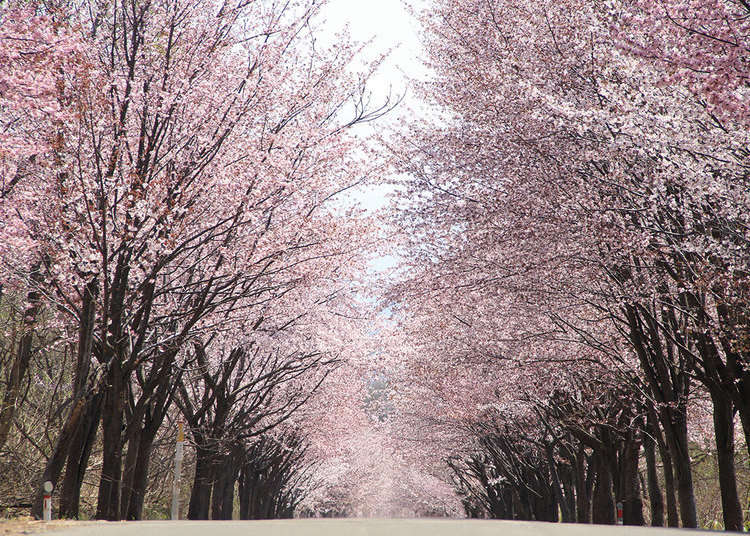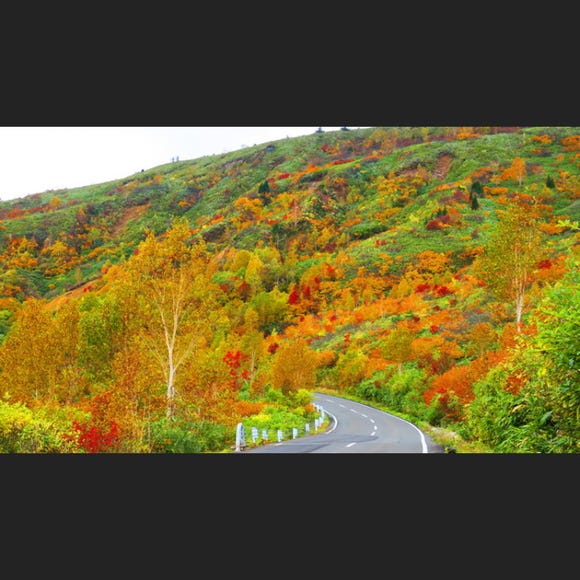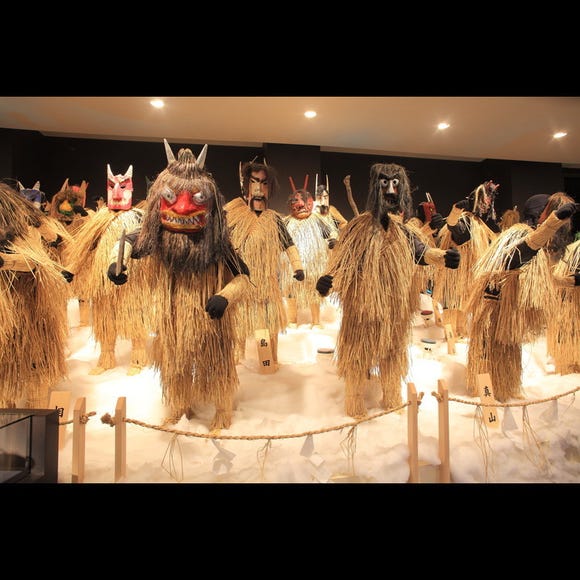
Hop to the northeast and you can find an incredible cherry blossom tunnel in Japan! The Iwaki district is west of Hirosaki City in Aomori Prefecture, and located at the foot of beautiful Mt. Iwaki is “The World's Longest Cherry Blossom-Lined Road.”
There, about 6,500 cherry trees line a 20km stretch of road and are in full bloom from late April to early May. In addition to this superb cherry blossom tunnel in Japan, there are even some great sightseeing spots like shrines and hot springs nearby, making for the perfect Japan trip.
What is “The World's Longest Cherry Blossom-Lined Road”?
After a 40-minute bus ride from JR Hirosaki Station to Komoriyama-iriguchi bus stop, you’ll arrive at a fantastic row of sakura cherry blossom trees that extends for about 20km along the prefectural roads in the Hyakuzawa-Dake area.
Started in 1985 with the planting of about 1,000 Oyamazakura cherry trees, it has become one of Aomori's leading sightseeing spots.

Inspired by local residents’ desires to create the longest sakura-lined road in the world, tree planting continued annually with about 6,500 planted by 1995. This sakura tunnel now seems to continue on forever and is beloved by locals and tourists alike.

Mornings are best! Enjoy different areas along this cherry blossom tunnel in Japan
To learn more about the best locations for photography along the sakura tunnel, we talked to Mr. Shinkichi Koyama of the Iwakisan Tourist Association, who has long been an admirer of the area’s cherry blossoms.

Mr. Koyama noted: “The first thing you need to know is that this row of cherry trees is at an altitude of 200 - 450m at the foot of Mt. Iwaki, with a maximum height difference of about 250m.
“Flowering is slower here than in the Hirosaki City area. It is difficult to predict exactly when the cherry blossoms will bloom, and there are gaps in each area. But those at low altitudes usually bloom around the end of April every year, with the higher-altitude ones blooming about 7 to 10 days later. You can enjoy the blossoms for more than 10 days.”
It’s exciting to monitor how each area is flowering while searching for the best spot at the best time!

If you’re looking for photos with early blooming sakura, the Hyakuzawa area is a prime location. On both sides of the Tsugaru Country Club’s backroads and the straightaway near Moriyama, the bright pink Oyama cherry blossoms display a different beauty from that of the Somei Yoshino variety.

The next best spot is also in the Hyakuzawa area. The road near Iwakisan Sogo Park has a gentle curve, offering a cherry blossom view with depth. It’s usually best seen from the beginning of May, and many tourists park their cars on the roadside to set up their cameras.

Mr. Koyama says, “Any time of day is beautiful, but the morning my recommendation.”
In the high-altitude morning sunlight, the pink blossoms and the greenery of the trees create a beautiful contrast that can only be captured at that moment.


Karekidaira, the endpoint of the sakura tunnel, is in full bloom in early May. Because of its proximity, it’s a recommended spot for closer shots of Mt. Iwaki and on a clear days, the scenery is truly dynamic.

Mr. Koyama admitted, “I actually hope to go out the day after some bad weather.”
Puddles on the road reflect the cherry blossoms like a watery mirror, and if taken from a low position, you can get a fantastic shot. So even if rainy weather seems disappointing during cherry blossom season, worry not! You can still get take your camera to Karekidaira the next morning.

As the blooming period approaches, the Iwakisan Tourist Association checks the state of the blossoms every morning and sends out flowering information earlier than anywhere else. You can check that information on their official website or by phone, with certainty that you have reliable local information before going out.

-
The World's Longest Cherry Blossom-Lined Road世界一の桜並木
- Address Susono Hyakuzawa, Hirosaki, Aomori 036-1343
-
Nearest Station
Access to The World's Longest Cherry Blossom-Lined Road
● Hyakuzawa area
About 40 minutes by Konan bus from JR Hirosaki Station to Komoriyama-iriguchi Bus Stop
● Karekidaira area
About 60 minutes by Konan Bus from JR Hirosaki Station, get off at Karekidaira Bus Stop
* The row of cherry trees near Iwakisan Sogo Park is easily walkable.
* Taking a bus or car is recommended for easier access to areas far from bus stops.
0172-83-3000 (Iwakisan Tourist Association)
Finish your trip to The World's Longest Cherry Blossom-Lined Road by visiting a few of the area’s other tourist spots.
Hirosaki City has plenty of restaurants and hot springs, but here are a few in the Iwaki district you should definitely check out!
Iwakiyama Shrine: Boasting a history of over 1200 years
Iwakiyama Shrine, located in Hyakuzawa about 2 km from the cherry blossom trees, enshrines Mt. Iwaki and has been a powerful site for worshippers since ancient times.
Originally dedicated to a god of agricultural and marine products, the shrine is now said to bring health, education, business, and marriage benefits, and is crowded with visitors on New Year’s Day.

Mt. Iwaki has long been called “O-Iwaki-sama” and “O-Yama” by local people in terms of familiarity and respect. On August 1st, prayers for a good harvest and household security are held along with a pilgrimage to Mt. Iwaki, further illustrating the mountain’s importance as a symbol of the Tsugaru region and a source of pride for local residents.

One of the main deities enshrined at Iwakiyama Shrine is Tatsubihime no Kami, a goddess of water. Drinking from the spring waters of the shrine’s ritual hand washing fountain is said to remove evil from the body.

Statues called “Tamagaki Komainu” are part of a stone fence on the shrine’s grounds. The upward-facing Komainu is believed to bring monetary fortune, while the downward facing one provides good fortune in love, so many visitors take photos with both.

The main shrine and hall of worship, built in the middle of the Edo period, are designated as important national cultural properties. The cleverly built exterior and the vivid patterns adorning the pillars are of particular interest. In spring, Iwakiyama Shrine is a place of new beginnings and hope for progress and success.
-

-
Address
27, Terasawa, Hyakuzawa, Hirosaki-shi, Aomori, 036-1343
View Map -
Nearest Station
Hirosaki Station (Ou Line)
40 minutes by bus
- Phone Number 0172-83-2135
-
Address
27, Terasawa, Hyakuzawa, Hirosaki-shi, Aomori, 036-1343
Hyakuzawa Onsen: Enjoy a soak before heading back!
The area around Mt. Iwaki has a wealth of hot springs, so after enjoying sakura viewing and a visit to the shrine, you can stop by the baths of Dake Onsen, Hyakuzawa Onsen, or one of ten other local hot springs to relieve the fatigue of your trip.

Hyakuzawa Onsen a popular drop-in hot spring located about a 10-minute walk from Iwakiyama Shrine.

The spring’s most notable quality is its iron content, which oxidizes when exposed to air. The concentration is high enough to discolor the surrounding ground and baths themselves an ocher hue. Hyakuzawa Onsen’s unique iron scent is also popular among hot spring enthusiasts, and with abundant hot water, you can enjoy this spring to your heart’s content.
(* Note that white towels will be discolored by the iron.)

Hyakuzawa Onsen’s spring is considered to be very hot with its 46°C temperature. However, lukewarm water is also available for those who don’t enjoy such long, hot baths. The waters seem to have positive effects on neuralgia and rheumatism.
While Hirosaki is known for severe fluctuations between morning and evening temperatures, which can be chilly even in spring and summer, there’s no need for concern about the cooling of Hyakuzawa Onsen’s baths.

A place for relaxation where many locals visit, you’ll have the opportunity to hear the Tsugaru dialect. After bathing, you can have a cup of coffee with milk as you finish your trip at this hot spring that will warm you inside and out.
-
Hyakuzawa Onsen百沢温泉
- Address 290-0 Terasawa, Hyakuzawa, Hirosaki, Aomori
- Phone Number 0172-83-2226
Hours: 10:00-22:00 (closed 4th Wednesday each month)
Admission: Adults (high school and older), 320 yen; elementary school students, 150 yen; kindergarten students, 60 yen; 3 years old and under, free; (all tax-included)
A final note concerning cherry blossoms: Hirosaki Park, home to Hirosaki Castle, is also known for its famous Hirosaki Sakura Festival but The World's Longest Cherry-Lined Road is still the winner.
Flowering tends to be earlier in urban areas, and with the right timing, you may be able to see both. If you’re that lucky, by all means, take plenty of photos of both, visit the hot springs in the Iwaki district and Iwakiyama Shrine, and enjoy your Hirosaki trip!
- Area
- Category
*Prices and options mentioned are subject to change.
*Unless stated otherwise, all prices include tax.
Popular Tours & Activitiess
Recommended places for you
-

Akiu Onsen
Hot Springs (Onsen) & Bath Houses (Sento)
Sendai And Matsushima
-

Ginzan Onsen
Hot Springs (Onsen) & Bath Houses (Sento)
Surrounding Areas Of Yamagata
-

Hachimantai Aspite Line
Landscapes
Morioka, Hiraizumi And Hachimantai
-

Aomori Museum of Art
Art Museums
Aomori, Hirosaki And Hachinohe
-

Namahage Museum
Other Museums
Surrounding Areas Of Akita
-

Matsushima Bay
Landscapes
Sendai And Matsushima
-

Dining in Yamagata: Must-Try Foods & Top Restaurants Near the Station
by: ShiroKu inc.
-

Niigata Sake no Jin 2026: Guide to Japan's Most Legendary Sake Weekend
-

What to Buy in Aomori? 11 Aomori Souvenirs Locals Actually Recommend
by: ShiroKu inc.
-
Ad

Just one stop from Haneda Airport! "Truly Japanese!" Food, Fun, and Knowledge Gather at HICityⓇ Enjoy An Electrifying Night at "Japan Night Fever: Haneda Innovation City"
by: Yohei Kato
-

Shopping in Niigata: 9 Must-Buy Souvenirs & Local Sake to Take Home
by: ShiroKu inc.
-

Aomori's Quiet Side in Autumn: 5 Scenic Spots in Hachinohe According to a Local
by: Marco Blasco
-

Takahan Ryokan: Enjoy Spectacular Hot Spring Views at Yuzawa's Premier Traditional Inn!
-

10 Beautiful Places in Miyagi Prefecture to See the Cherry Blossoms in 2025
by: Alexander Litz
-

Top 10 Places in Aomori to See the Cherry Blossoms in 2026
by: Alexander Litz
-

(Video) Walking Tour along Narita Omotesando - Quaint Historical Village near Narita Airport!
by: Victor Gonzalez
-

Enjoy the Gorgeous Hirosaki Cherry Blossom Festival in Aomori (April-May 2026)
by: Alexander Litz
-

Because Tokyo is Too Crowded: 15 Cherry Blossom Spots in Tohoku, Northern Japan (Blooming: Late April 2026)
















